How to Cook a Turkey Dinner!
Fully illustrated, easy and Great tasting!
So it's your turn to cook the turkey and you've never done it, or you're worried about Uncle Phil and Aunt Jane and the rest of the McCracken family complaining that it is too dry, overcooked or undercooked? Can't read the tiny print on the turkey wrapper to figure out how long to thaw or cook it? Fear not, following these directions ANYONE can cook a perfect turkey dinner for Thanksgiving, Christmas or any occasion! If you would rather smoke the turkey, see this page !
Ingredients and Equipment
- Turkey - uncooked, frozen or
fresh,
with or without neck and giblets,
with or without broth injected - note:
you can now get organic and kosher
turkeys - at about double the price - but without any hormones!
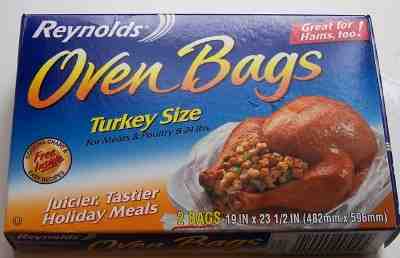
- Herbs: Thyme, sage, marjoram, paprika, rosemary, pepper
- 2 medium onions or one large onion
- Turkey cooking bag
- Meat thermometer
- Large oven cooking pan (must be oven-safe)
Step 1- Gather the pan and cooking bags
Oven bags are the easiest way to guarantee a moist turkey, and easy clean up. I have no affiliation with the manufacturers of these or any cooking bags - I juts have used them for years and find that they really do work.
There is no pot to scrape and clean afterwards, and the juices and moisture is kept in with the turkey, so no basting is required, either! You can use a roasting pan (with a lid) instead, the bags just make cleanup easier and hold in more moisture.
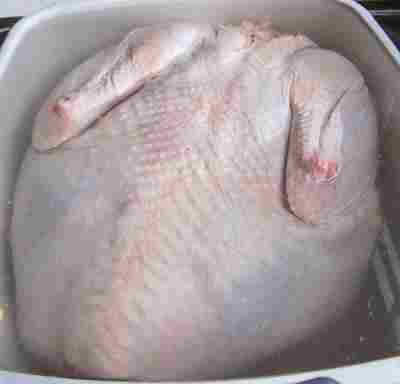 Step 2 - Thaw the turkey
Step 2 - Thaw the turkey
If you bought a frozen turkey, you must thaw it before preparing or
cooking it! There are always directions for thawing on the bag,
but basically, there are two methods:
- 1 to 3 days in the refrigerator or
- submerged in cold water for about 3 - 6 hours (depending on
the size of the turkey). It is safer to thaw it in the fridge, since
it is always kept before below 40 degrees F, but sometimes, there just isn't time.
If you thaw it under water, be sure to change the water every 30 minutes or so. Make sure you keep the entire turkey under water. Parts expose to air will warm to room temperature, and bacteria can grow!
THAWING TIMES FOR A TURKEY |
||
| Turkey Size (lbs.) | Refrigerator (Days) | Cold Water (Hours) |
| 8-12 | 1-2 | 4-6 |
| 12-16 | 2-3 | 6-8 |
| 16-20 | 3-4 | 8-10 |
| 20-24 | 4-5 | 10-12 |
Step 3 - Empty and clean the turkey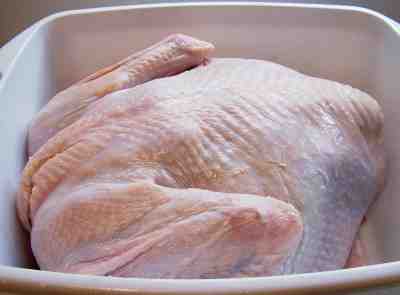
Remove any neck and giblets that were stuffed inside the turkey - be sure to look in BOTH ends - often they put a gravy packet under the neck skin flap, and the giblets are inside the bird.
Thoroughly wash the turkey inside and out with cold water (nothing else) and drain it. Note: this is a good time to get the oven warming - set it for 325 F (and make sure there is nothing inside the oven first!)
Remember that uncooked poultry usually have bacteria like salmonella, so thoroughly wash your hands, and pots, tools, or surfaces that come in contact with the uncooked turkey. Use hot soapy water and rinse a lot on nonfood items (your hands, pots, etc.).
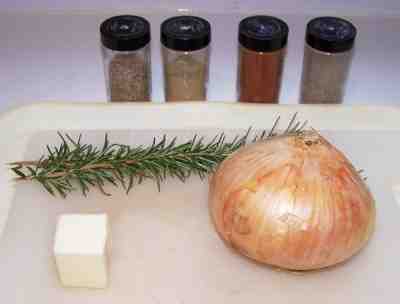 Step 4 - Gather the seasonings
Step 4 - Gather the seasonings
The seasonings are easy:
1 teaspoon Thyme
1 teaspoon Sage
1/2 teaspoon Marjoram
1/4 teaspoon Paprika
1/2 teaspoon dry Rosemary, or 2 sprigs fresh.
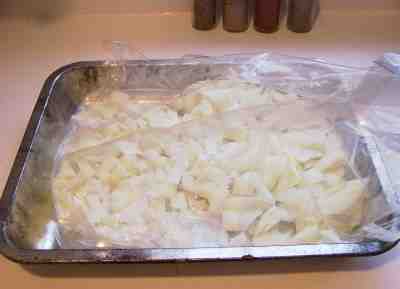
Dice the onion(s) - I do about 1/4 inch squares but anything from 1/2 inch slices or smaller is fine. Place the cooking bag in the cooking pan and line the inside of the cooking bag with the onions.
Step 5 - Stuffing the turkey?
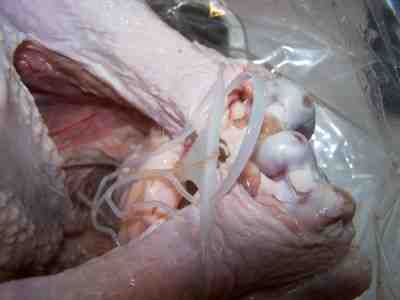 Personally, I don't think it's a good idea to stuff the inside of the
turkey with dressing - it makes it harder to ensure that the turkey is
cooked completely, and the stuffing absorbs the blood and other fluids and
insulates the bacteria in them from the heat. If the stuffing is
not cooked and handled properly,
foodborne illness
could occur. I cook the stuffing in a separate covered pan and add cooked
juice from the turkey to it!
Personally, I don't think it's a good idea to stuff the inside of the
turkey with dressing - it makes it harder to ensure that the turkey is
cooked completely, and the stuffing absorbs the blood and other fluids and
insulates the bacteria in them from the heat. If the stuffing is
not cooked and handled properly,
foodborne illness
could occur. I cook the stuffing in a separate covered pan and add cooked
juice from the turkey to it!
If you DO stuff the turkey, undo the plastic strap that holds the legs together and LOOSELY stuff both cavities (neck and thoracic)., then replace the legs in the strap. You cook the bird with this strap in place - it is oven-safe!
More notes on stuffing from Clemson University:
Prepare Stuffing Safely: Mix the stuffing just before it goes into the turkey. Use only cooked ingredients in stuffing such as sauteed vegetables, cooked meats and seafood (oysters), and pasteurized egg products instead of raw eggs. If more convenient, the wet and dry ingredients can be prepared separately ahead of time and chilled. Mix the ingredients just before placing the stuffing inside the turkey or in a casserole.
Stuff The Bird Properly: Stuff both neck and body cavities. The turkey should be stuffed loosely, about three-quarters cup of stuffing per pound of turkey. This will help allow the stuffing to reach the proper 165 degrees F internal temperature whether the stuffing is in the bird or in a casserole. Use a meat thermometer to be sure of the temperature. The stuffing should be moist, not dry, since heat destroys bacteria more rapidly in a moist environment.
Cook At The Proper Temperature: The stuffed turkey should be placed immediately in a preheated oven set no lower than 325 degrees F. Cooking overnight in a "slow" oven is not recommended for stuffed or unstuffed turkey, since foodborne bacteria can form under these conditions.
Use A Meat Thermometer: Checking the stuffing temperature with a thermometer is essential. That is because even if the turkey itself has reached the proper internal temperature of (165 degrees F min to 180 degrees F max) in the innermost part of the thigh, the stuffing may not have reached the correct temperature of 165 degrees F in its center. It is important to reach this temperature in all parts of the stuffing to be sure that foodborne bacteria are destroyed.
Prestuffed Poultry:
Buying retail-stuffed whole poultry is not
recommended because of the highly perishable nature of a previously stuffed
item. Some USDA-inspected frozen stuffed poultry MUST be cooked from the
frozen state to ensure a safely cooked product.
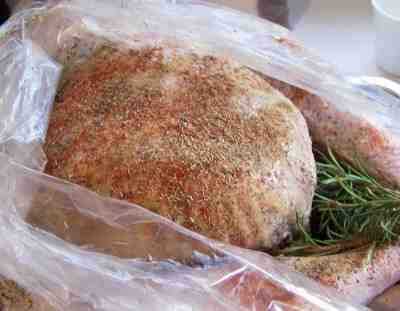
Step 6 - Season the Turkey!
Brush with oil or melted butter to prevent drying of the skin and help it to become a golden brown.
Put the turkey into the oven bag, then sprinkle the seasonings from step 4 all over the bird. Now closew the bag according to the instructions that came with it (a twist-tie around the opening and punch a small hole near it to release excess pressure.
Insert an oven-safe meat thermometer into the deepest part of the thigh. (If using an instant-read thermometer, it will be inserted when it is time to check for doneness.)
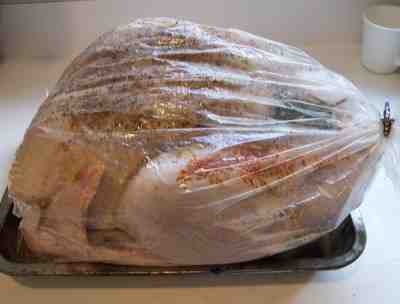 Step
7 - Put the turkey in the oven
Step
7 - Put the turkey in the oven
Place in a preheated 325 degrees F oven. Use the roasting schedule in Table 2 as a guideline; start checking for doneness a half-hour before recommended end times.
APPROXIMATE ROASTING TIMES FOR TURKEY |
||
| Size of Turkey (lbs.) | Unstuffed Timing | Stuffed Timing |
| 8-12 | 23/4 - 3 Hours | 3 - 3-1/2 Hours |
| 12-14 | 3 - 33/4 Hours | 3-1/2 - 4 Hours |
| 14-18 | 33/4 - 41/4 Hours | 4 - 41/4 Hours |
| 18-20 | 41/4 - 4-1/2 Hours | 41/4 - 43/4 Hours |
| 20-24 | 4-1/2 - 5 Hours | 43/4 - 51/4 Hours |
Turkey is done when the meat thermometer reaches the following temperatures:
180 to 185 degrees F deep in the thigh; also, juices should be clear, not pink when
thigh muscle is pierced deeply.
170 to 175 degrees F in the thickest part of the breast, just above the rib bones.
160 to 165 degrees F in the center of the stuffing, if turkey is stuffed.
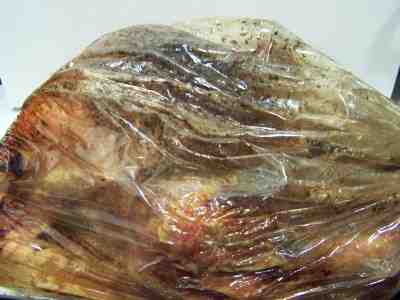
Most authorities are now saying that once all parts of the turkey reach 165 degrees F, it is safe to eat. 180 degrees F is a pretty dry turkey, so if you test in the three place above and all are at least 165 degrees F, it should be ready!
Step 8 - remove the cooked turkey
When the skin is a golden color and the thermometer reads the right temperature from step 6, take it out of the oven!
Let turkey stand for 15 to 20 minutes before carving to allow juices to set. While the turkey is setting, you can make the gravy!
Step
9 - Make the gravy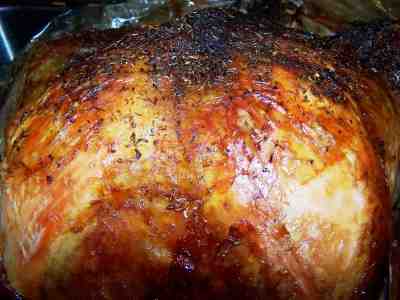
Click here for the gravy directions!
Step 10 - You're done!
Within two hours after roasting, remove stuffing from turkey and carve the meat off the bones; then store in refrigerator or freezer. Gravy, stuffing and meat need to be stored SEPARATELY from each other. Wrap turkey slices and stuffing separately.
Refrigerator Storage: Use within three days.
Freezer Storage: Wrap in heavy foil or freezer wrap or place in freezer container. For optimum taste, use stuffing within one month and turkey within two months.
- Looking for simple apple pie directions ?
- How about a pumpkin pie made from a fresh pumpkin, squash, or canned pumpkin?
- And for even more detailed turkey instructions see Clemson University's page!
For Easter egg Hunts, Children's Consignment Sales, Local Farm Markets and other types of Farms, click here.
Find Other types of farms:
- Farm markets and roadside stands
- Road trips and camping resources
- Home canning supplies at the best prices on the internet!
- Maple Syrup Farms, sugarworks, maple syrup festivals
- Environmental information and resources
- Consumer fraud and scams information
- Farms For Your Event for birthday parties, weddings, receptions, business meetings, retreats, etc.
- Pick Your Own fruits and vegetable farms
- Festivals - local fruit and vegetable festivals
- Local Honey, apiaries, beekeepers
- Local Meat, Milk and Eggs
Get the
most recent version of
the Ball Blue Book
Find Other types of farms:
- Farm markets and roadside stands
- Road trips and camping resources
- Home canning supplies at the best prices on the internet!
- Maple Syrup Farms, sugarworks, maple syrup festivals
- Environmental information and resources
- Consumer fraud and scams information
- Farms For Your Event for birthday parties, weddings, receptions, business meetings, retreats, etc.
- Pick Your Own fruits and vegetable farms
- Festivals - local fruit and vegetable festivals
- Local Honey, apiaries, beekeepers
- Local Meat, Milk and Eggs
Get the
most recent version of
the Ball Blue Book